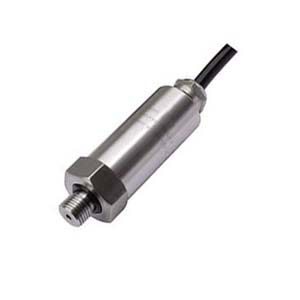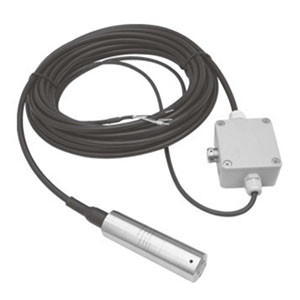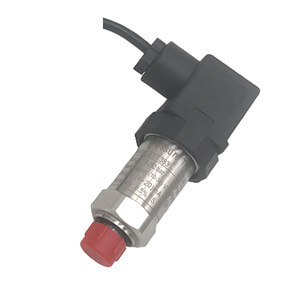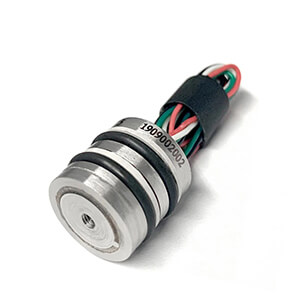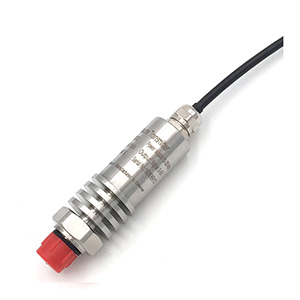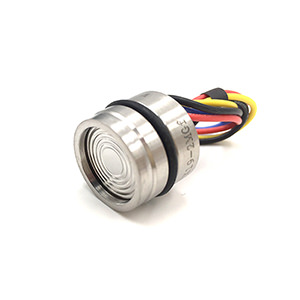The temperature has a significant impact on pressure sensor performance and accuracy. Most pressure sensors are designed to withstand specific temperature ranges, which can greatly influence their measurement accuracy. This is primarily because the sensing element and other components expand and contract due to temperature changes, which in turn affects the output signal.
For instance, a pressure sensor designed for a standard temperature range (e.g., -20°C to 85°C) might not function correctly under extremely low temperatures (e.g., -50°C or lower). The materials and components can become brittle at such low temperatures, leading to sensor failure or inaccurate measurements.
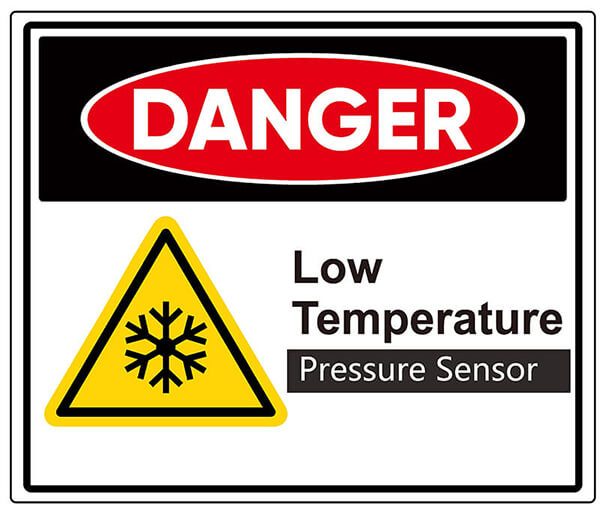
What Happens to Pressure Sensors Under Low and Extreme Low Temperatures?
When a pressure sensor is subjected to low and extremely low temperatures, several issues may arise:
- Material Changes: The sensing element and other components can contract due to the decrease in temperature. This can cause the material to become brittle and increase the risk of cracking, leading to sensor failure or reduced measurement accuracy.For instance, metals typically undergo contraction when subjected to low temperatures, which can lead to changes in the sensor’s dimensions, potentially impacting its performance and accuracy.Additionally, the Young’s modulus of materials, which defines their stiffness, may also be affected by temperature variations. For example, the modulus of steel decreases by about 2% for every 100°C decrease in temperature. It’s essential to consider the materials’ responses to low temperatures when designing a sensor for these conditions.
- Output Signal Drift: The change in temperature can cause the output signal to drift. This is because the transduction mechanism, typically a piezoresistive or capacitive element, is sensitive to temperature variations, which can lead to an inaccurate pressure reading.For example, piezoresistive pressure sensors might experience a change in resistance, which can alter the output voltage and result in inaccurate readings. Engineers typically implement temperature compensation techniques to combat this issue to ensure accurate output signals, regardless of temperature fluctuations.
- Increased Noise: Low temperatures can also increase the electrical noise within the sensor, hindering the signal processing circuitry from accurately measuring the pressure change. The signal-to-noise ratio (SNR) can deteriorate in such conditions, resulting in lower measurement quality.To minimize the impact of increased noise, engineers must design pressure sensors with proper noise reduction techniques, such as utilizing low-noise amplifiers and employing appropriate filtering techniques.
- Lubrication Challenges: In mechanical pressure sensors, such as those found in hydraulic systems, the lubricating fluids can become more viscous at low temperatures, increasing friction and reducing sensor responsiveness. Low and extremely low temperatures can cause lubricants to thicken or solidify, leading to increased friction and wear. To overcome this challenge, selecting the right lubricant with a suitable temperature range and ensuring proper lubrication of the sensor’s moving parts is essential.
Pressure Sensor Performance Under Various Temperature Conditions_
| Temperature Condition | Material Contraction | Output Signal Drift | Electrical Noise | Lubrication Challenges |
|---|---|---|---|---|
| Standard Range (-20°C to 85°C) | Minimal | Slight | Moderate | Minimal |
| Low Temperatures (-40°C) | Moderate | Moderate | High | Moderate |
| Extreme Low Temperatures (-50°C or lower) | Significant | Significant | Very High | Significant |
Common Issues with Pressure Sensors in Cold Climates
1. Material Contraction and Its Effects on Sensor Accuracy
Material contraction is a prominent issue when pressure sensors operate in cold climates. As the temperature decreases, the sensing element and other components contract, increasing their brittleness and the risk of cracking. This can lead to sensor failure or reduced accuracy in measurements.
For instance, silicon-based sensing elements may experience non-linear response or increased hysteresis at low temperatures due to their increased brittleness. Additionally, the seals and adhesives used in pressure sensor assembly can lose their elasticity, impacting the sensor’s long-term stability and reliability.
2. Power Supply Concerns: How Cold Affects Battery Life
Battery life is another critical concern when using pressure sensors (battery-powered) in cold environments. Low temperatures can significantly reduce a battery’s capacity, leading to shorter operating times and diminished sensor performance.
Cold temperatures can induce a higher internal resistance within the battery, leading to voltage drops and reduced efficiency. Moreover, chemical reactions inside the battery responsible for generating electrical energy slow down at low temperatures, further impacting battery capacity.
To ensure optimal power supply performance in cold conditions, consider using batteries specifically designed for low temperatures or incorporating a heating mechanism to maintain battery temperature within an optimal range.
3. Challenges with Data Transmission in Frigid Conditions
Data transmission can pose challenges for pressure sensors in cold climates. Wiring and connection materials can become brittle, leading to increased resistance and possible signal loss. Wireless communication modules may also experience challenges in low temperatures, affecting radio frequency signal strength and increasing the risk of data packet loss or corruption.
To address data transmission challenges in cold environments:
- Utilize high-quality, cold-resistant cablesand connectors to reduce signal loss and maintain reliable communication.
- Implement redundancy or error-correcting protocols when using wireless data transmission methods, ensuring data is accurately received and transmitted.
- Incorporate enclosures or heating mechanisms to protect the sensor’s electronics and maintain optimal operating temperature for components involved in data transmission.
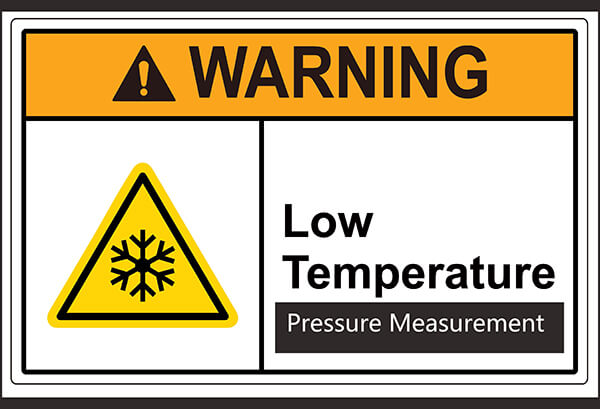
Innovative Material Choices for Cold-Resistant Pressure Sensors
The Role of Materials in Sensor Performance
The choice of materials plays a critical role in pressure sensors’ overall performance and durability, primarily when operating in cold climates. Selecting materials that can withstand temperature fluctuations and maintain their structural integrity is essential to ensure accurate sensor readings and long-lasting performance.
Materials used in sensor construction, such as diaphragms, seals, adhesives, and connectors, need to be carefully evaluated for their suitability in low-temperature applications. Cold-resistant materials reduce the risk of material contraction and brittleness and enhance the sensor’s resistance to temperature-induced output signal drift, ensuring high measurement accuracy.
Silicon, Sapphire, and More: Robust Materials for Low-Temperature Sensors
Several innovative materials have been tested and proven to be effective for pressure sensors in cold climates. Some of these materials include:
Silicon-on-sapphire:
This combination leverages the mechanical and electrical stability benefits of sapphire, a single-crystal material that exhibits exceptional rigidity and maintains its properties across a wide temperature range. Silicon-on-sapphire pressure sensors offer high resilience, minimal output signal drift, and excellent performance under extreme low temperatures.
Benefits and advantages of Silicon-on-sapphire:
- Sapphire has extremely low permittivity and high resistivity, resulting in very low leakage current even at cryogenic temperatures. This allows the sensor to operate reliably down to -200°C.
- The coefficient of thermal expansion (CTE) match between silicon and sapphire minimizes thermally induced stress and resulting sensor drift over temperature.
- Sapphire is very mechanically and chemically robust, making it suitable for harsh environments.
Common silicon-on-sapphire sensor specifications for low-temperature operation:
- Temperature range: -200°C to +200°C
- Pressure range: Atmospheric and sub-atmospheric
- Sensitivity: 50-500 mV/V
- Non-linearity: <1% BFSL
- Stability: <0.25% BFSL (-55°C to +125°C)
- Response time: <1 ms
Stainless steel diaphragms:
Stainless steel diaphragms have been utilized in pressure sensors for their outstanding mechanical strength, making them a viable choice for low-temperature applications. Special grades of stainless steel can further enhance the low-temperature performance, providing increased durability and corrosion resistance.
Benefits and advantages of Stainless-steel diaphragms
- Higher strength – Stainless steel remains relatively strong even at low temperatures, while silicon becomes quite brittle.
- Lower coefficient of thermal expansion – The CTE of stainless steel is lower and remains stable to -196°C, reducing thermally induced errors in the sensor.
- Higher thermal conductivity – Stainless steel conducts heat more efficiently, allowing any temperature variations to equalize more quickly across the diaphragm.
Common specifications for stainless steel diaphragm pressure sensors for low temperatures:
- Pressure ranges: Up to 10,000 psi
- Sensitivity: 0.5 to 10 mV/V/psi
- Non-linearity: <0.25% full scale
- Non-repeatability: <0.1% full scale
- Material: 316L stainless steel
- Temperature range: -196°C to +200°C
Check the datasheet of EST380S-C, Thin-Film type pressure transducer for Cryogenic, working under -196℃-85℃
- Accuracy: ±0.2%F. S |: ±0.5%F. S
- Range: 0~1Mpa~300Mpa
- Sensing: Thin-Film
- Stability: ±0.2%F. S
- All-Welded Stainless-Steel
- Ultralow Temperature for Cryogenic Industry: -196~85℃
- Medium: Liquid Oxygen (LOX) | Hydrogen | Nitrogen
Low-temperature elastomers:
Elastomeric seals and sensing elements are required in many pressure sensors to isolate media and transmit pressure, respectively. However, standard elastomers become brittle and lose elasticity at cryogenic temperatures. Special low-temperature elastomers must be used, with the following key properties:
Benefits and advantage of elastomeric elements
- Low glass transition temperature (-50°C to -100°C) – Ensures the material remains elastic and usable at low temperatures.
- Superior elasticity and elongation at low temperatures – Maintains sealing ability and transduces pressure evenly to the sensing element.
- Minimal compression set – Allows the material to recover fully after cyclic compression, avoiding permanent deformation.
Common low-temperature elastomers used in pressure sensors include:
- Kalrez – A perfluoroelastomer with very low compression set and glass transition temperature of -20°C. Usable to -200°C.
- Viton – A fluorocarbon elastomer with a glass transition of -15°C. Usable to -50°C.
- Silicone – Several high-performance silicones are available with glass transitions as low as -100°C. Usable to -80°C.
- Fluorosilicone – Combines silicone and fluoropolymer capabilities with glass transitions below -100°C. Usable to around -100°C.
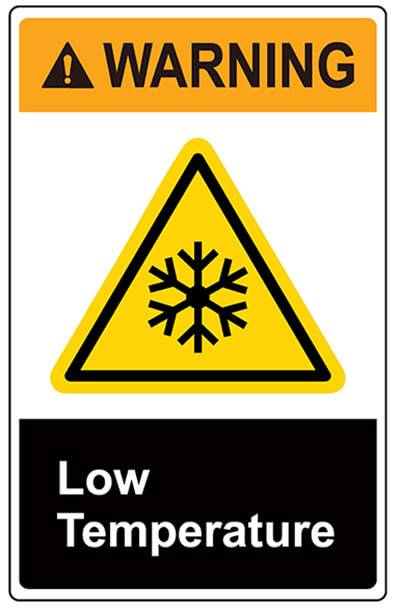
Design Considerations for Low-Temperature Pressure Sensors
The Importance of Thermal Isolation in Sensor Design
Thermal isolation plays a critical role in optimizing the performance of pressure sensors in cold environments. By effectively isolating the sensing element and electronics from temperature fluctuations, you can minimize the impact of temperature-induced drift and noise in the output signal, ensuring accurate and stable measurements.
There are several ways to achieve thermal isolation in sensor design:
Selection of thermally stable materials:
When designing pressure sensors for cryogenic temperatures, one of the most important factors is selecting thermally and mechanically stable materials at low temperatures. This includes:
- Sensor element material: As discussed previously, silicon-on-sapphire and stainless steel sensing elements are well suited for low temperatures due to their stable properties down to -200°C.
- Dielectric and insulating materials: Materials like sapphire, alumina, and quartz show very low leakage currents at cryogenic temperatures, making them suitable for electrical insulation.
- Elastomers and seals: Special low-temperature elastomers like Kalrez, fluoride rubber, and silicone retain their elastic properties and sealing ability below -100°C.
- Adhesives: Epoxies and glues used to assemble sensor components must maintain mechanical stability and resist embrittlement at cryogenic temperatures.
- Electrical connections: Wire materials like manganin, copper beryllium, and high-purity copper conduct heat efficiently and show minimal electron scattering at low temperatures.
- Packaging: Sensor housings are typically made from stainless steel, aluminum alloys, or other non-magnetic metals, as plastics become brittle at low temperatures.
Careful materials selection is key to achieving stable, repeatable performance from pressure sensors at cryogenic temperatures. Avoid materials with high coefficients of thermal expansion or those that become embrittled, cracked, or lose elastic properties below their glass transition temperatures.
Incorporating thermal barriers:
Another important design consideration is incorporating thermal barriers to isolate the sensor element from large thermal gradients and heat losses. This includes:
- Dielectric standoffs: Materials like sapphire, alumina and glass cylinders are used to suspend the sensor element within the sensor body. This provides electrical insulation and thermal isolation.
- Low-conductivity elastomers: Soft elastic materials with lower thermal conductivity like silicone and fluorosilicone can be used for seals and thermal standoffs to isolate the sensor element.
- Hollow spacers: Small hollow cylinders made of stainless steel or other low-conductivity materials provide both mechanical support and thermal isolation for the sensor element.
- Electrical leads: Fine gauge wire leads provide the smallest possible thermal pathway between the sensor element and other warmer components. Using twisted pairs or coils can further reduce thermal conduction.
Together, these thermal barriers help maintain a stable temperature environment for the sensor element, reducing temperature gradients and resulting measurement errors during rapid cryogenic temperature changes. Without adequate thermal isolation, self-heating effects from electrical currents or external heat sources can significantly impact sensor accuracy.
Heating elements:
In some cases, small localized heating elements may be incorporated into the pressure sensor design to provide temperature stabilization of the sensor element. Example applications include:
- Thin-film resistive heaters: Very small heaters made from doped silicon, tantalum nitride or other thin films can be integrated on the backside of the sensor element. Precise resistive films allow accurate temperature control.
- Wire-wound heaters: Tiny coils of fine gauge constantan or manganin wire can be wrapped around the sensor element for heating. Temperature is proportional to heater power.
- Thermoelectric heaters: Miniature Peltier devices can both heat and cool the sensor element under software control for precise temperature stabilization.
Heater control is provided by a feedback loop incorporating a temperature sensor (RTD, thermistor or diode) located on the sensor element. A microcontroller adjusts heater power to maintain a setpoint temperature, compensating for changes in ambient conditions and self-heating effects.
Localized heating can significantly improve the stability, accuracy and repeatability of pressure sensors operating at or below room temperature. However additional complexities relating to thermal time constants, heat leakages and self-heating effects must be carefully considered.
Why Sealing is Crucial for Sensors in Cold Environments
Effective sealing is essential for maintaining pressure sensors’ long-term durability and reliability in cold environments. Exposure to low temperatures may cause the seals and gaskets to become brittle and lose their elasticity, increasing the risk of leaks and compromising the sensor’s performance.
To ensure reliable sealing in cold conditions, consider the following design aspects:
Use cold-resistant sealing materials:
Properly sealing sensors against extreme cold is critical to ensure reliable performance. Standard rubber seals and adhesives will become brittle and crack at cryogenic temperatures. Instead, seals made from specialized low-temperature materials must be used, such as:
- Fluorocarbon elastomers: Viton, Kalrez and Chemraz offer excellent chemical stability and can withstand temperatures as low as -200°C. They maintain flexibility at low temperatures better than silicone.
- Silicone: Several high-performance silicone formulations exist with service temperatures down to -80°C. They offer good compressive set resistance and release after extended compression.
- Fluorosilicone: Combining silicone and fluoropolymer properties, fluorosilicates are extremely flexible and elastic even at -100°C. They exhibit minimal crystallization and resist cracking.
- PTFE thread seal tape: PTFE tape is commonly used to seal threaded connections at cryogenic temperatures. It handles extreme compression and has a service range from -250°C to +260°C.
- Epoxy adhesives: Specific epoxies have been formulated for bonding at cryogenic temperatures down to -200°C. They resist embrittlement and exhibit high shear and tensile strength.
Seal Material Temperature Range
- Fluorocarbon -200°C to +205°C
- High-performance Silicone:-115°C to +205°C
- Fluorosilicone:-100°C to +205°C
- PTFE Tape:-250°C to +260°C
- Epoxy Adhesive:-200°C to +150°C
Optimize the seal geometry and design:
In addition to proper material selection, carefully optimizing seal geometry can maximize sealing performance at cold temperatures:
- Increase seal surface area: Wider seals in contact with more mating surfaces provide greater compressive force and better sealing.
- Provide redundant sealing: Multiple seals in series increase reliability by ensuring at least one maintains a seal under extreme conditions.
- Minimize seal compression: Only the amount of compression required for sealing should be applied. Excessive initial compression leads to reduced flexibility at low temperatures.
- Avoid sharp corners: Rounded edges and corners in the seal design minimize stress concentrations that can lead to cracking.
- Implement relief channels: Microchannels or grooves provide space for the seal to expand without excessive compressive stress as temperatures decrease.
- Use lubricants: Applying silicone- or fluorocarbon-based lubricants to the seal before assembly enhances compression, reduces wear and aids in relieving mechanical stresses.
Proper seal geometry and design principles allow the material to maintain its elastic properties and continue providing an effective seal, even under the compression set caused by thermal contraction at cryogenic temperatures.
Implement redundant sealing mechanisms:
Incorporating redundant seals in the sensor design can enhance the overall sealing reliability, ensuring that the sensor operates effectively even if one of the seals fails.
For the most critical cryogenic sealing applications, implementing redundant sealing mechanisms provides the highest reliability:
- Double O-ring seals: An outer O-ring provides primary sealing while an inner o-ring acts as a backup in case the primary seal fails.
- Metal end cap seals: A soft O-ring or gasket provides the primary seal, with a metal end cap compressing the seal as a secondary mechanism.
- Metal diaphragm seals: A metal diaphragm or bellows compresses a soft gasket or O-ring to provide a secondary sealing mechanism.
- Metal flanges with gaskets: Metal flanges bolt together, compressing a gasket to provide a secondary sealing surface in addition to the primary o-ring seal.
Redundant sealing is particularly critical for applications involving high pressures, extreme environments or where leaks cannot be tolerated. The secondary seal acts as a safety mechanism to ensure containment during primary seal failure due to cracking, extrusion or other issues.
Balancing Sensor Size and Power for Low-Temperature Operations
In cold environments, it is essential to strike a balance between sensor size, power consumption, and sensor performance:
Optimizing sensor size:
Reducing the sensor size can help minimize heat loss, as smaller devices have a reduced surface area exposed to the cold environment. However, this must be balanced with the need to maintain internal temperature control and sufficient electronic components.
For applications requiring extremely small, lightweight sensors operating at cryogenic temperatures, proper design of the sensor packaging and mechanisms is critical:
- Use the minimum necessary housing material. Thin yet robust packages made from materials like stainless steel or aluminum alloy provide thermal isolation while minimizing mass and size.
- Design resonant sensing elements with low mass. Thin diaphragms, beams and membranes reduce heat capacity and allow faster thermal stabilization.
- Integrate MEMS technology where possible. Microelectromechanical systems integrate sensing and electronics onto a single tiny silicon chip, reducing package size requirements.
- Incorporate thermal barriers. Hollow tubes, spacers and dielectric standoffs provide isolation while minimizing cupped volume in the sensor design.
- Avoid unnecessary components. Remove all features not critical to sensor function to minimize size and thermal mass.
- Utilize 3D printing where feasible. Additive manufacturing enables creation of custom minimalist housings tailored for cryogenic use.
Optimizing sensor design for minimal size and mass allows for faster thermal stabilization during temperature changes, reduces power consumption requirements and eases integration into constrained environments. However, ensuring structural and thermal robustness remains critical even with a compact design.
Managing power consumption:
Low temperatures can negatively affect battery performance, as discussed previously. To extend the operating time and minimize the impact on sensor performance, optimizing power consumption through efficient electronics, power-saving modes, and energy harvesting techniques is essential if feasible.
- Use low-power sensing circuits. Design circuits with low quiescent current draw, and activate high-current components only when taking measurements.
- Incorporate duty cycling. Only power on electronics and heaters when needed, leaving in low-power modes between readings.
- Select low-power microcontrollers. Microcontrollers designed for “energy harvesting” applications require as little as 1 μA during sleep.
- Use efficient heating elements. Choose thin-film heaters with low resistances requiring less power input.
- Insulate heating elements. Thermally isolate heaters from othercold components to minimize wasted heat.
- Control heater setpoint tightly. Narrow PID control loops supply the minimum power needed to maintain temperature.
Lower sensor power consumption eases integration into battery-powered or energy-harvesting systems. However, providing enough power for infrequent self-heating or thermal stabilization remains a challenge, especially at small sensor sizes. Optimized designs must balance performance requirements with available power budgets.
Integrating compact heating elements:
Heating elements can help maintain sensor temperature and performance but consume energy and add size to the sensor. The balance between sensor size, power consumption, and performance can be achieved by incorporating compact, energy-efficient heating solutions.
For applications requiring minimal sensor size but also precise thermal control, highly integrated nanoscale and microscale heating elements can be designed:
- Thin-film resistive heaters allow extremely compact and precise heating using less than 1 mW of power. Common materials include platinum, titanium nitride and doped silicon.
- Nanowire and carbon nanotube heaters offer even higher power densities with small footprints. However they are difficult to integrate and control precisely.
- Micro Peltier devices can both heat and cool using the Thomson and Peltier effects. However they require more power and delicate packaging.
- Integrated microhotplates provide local heating for chemical sensors and lab-on-a-chip applications. They can reach temperatures up to 500°C in a footprint of only a few mm2.
Despite their compactness, challenges remain in controlling and reliably operating these advanced heating technologies. Tradeoffs must be made between heater size, efficiency, precision and overall sensor complexity. But for applications where thermal stabilization is critical yet size is highly constrained, nanoscale and microscale heating elements provide a feasible solution.
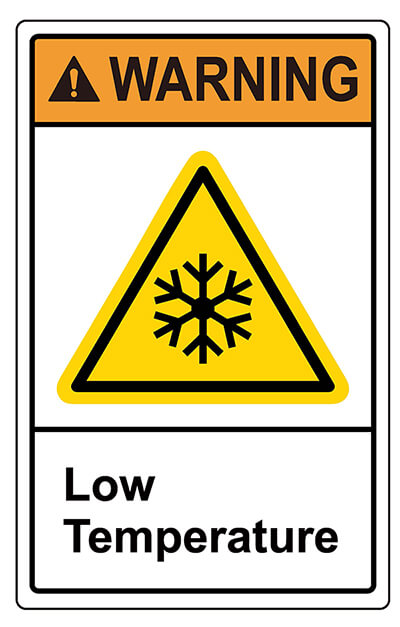
Technological Solutions for Pressure Sensors Under Low Temperatures
Heat Compensation Techniques for Maintaining Sensor Accuracy
Heat compensation techniques are essential for maintaining sensor accuracy under low temperatures. These methods help counteract the negative effects of temperature fluctuations on the sensing element and signal. Some noteworthy heat compensation techniques include:
Active temperature compensation:
Using additional temperature sensors to monitor the sensing element’s temperature can provide data to compensate for temperature-induced signal drift. Through the use of a microcontroller or advanced signal processing, the raw pressure sensor output can be adjusted for temperature variations, ensuring accuracy in the final pressure measurement.
Passive thermal isolation:
Implementing insulation materials or layers in the sensor design to create a barrier between the sensing element and the rest of the sensor can help minimize the effect of extreme temperature fluctuations on sensor performance.
Integrated heating elements:
Embedding low-power heating elements in the sensor design can help maintain a stable temperature around the sensing element, avoiding temperature-induced errors and minimizing the risk of material brittleness.
Harnessing Advanced Technologies for Improved Data Transmission
Ensuring reliable data transmission is crucial for pressure sensors operating under low temperatures. Harnessing advanced technologies can improve data transfer reliability and efficiency in these challenging conditions:
- High-quality, cold-resistant cables and connectors: Using cables and connectors with robust materials and insulation can protect against signal loss and maintain reliable communication in frigid environments.
- Redundancy and error-correcting protocols: Incorporating redundancy or error-correcting protocols in wireless communication systems can ensure accurate data transmission and reception even under poor signal conditions.
- Utilizing modern wireless communication standards: Leveraging advanced wireless communication standards, such as LoRa, NB-IoT, or LTE-M, can provide improved signal penetration, range, and robustness, ensuring reliable data transmission in cold climates.
By integrating technological solutions to address the challenges of heat compensation, energy efficiency, and data transmission, pressure sensors can deliver reliable and accurate performance, even in low and extreme low-temperature conditions.
Real-World Applications of Low-Temperature Pressure Sensors
Space Exploration: Working in the Extreme Cold of Outer Space
In space exploration, low-temperature pressure sensors are essential for monitoring the pressure in fuel tanks, life support systems, and other mission-critical applications. The extreme cold and vacuum of space demand highly accurate and reliable sensors capable of withstanding these harsh conditions.
By employing advanced materials, thermal compensation techniques, and energy-efficient designs, pressure sensors can maintain their accuracy and reliability during space launches, orbital operations, and interplanetary missions. These sensors contribute to ensuring the success and safety of both crewed and uncrewed space missions.
Arctic Exploration and Climate Research: Unyielding Against the Polar Cold
Low-temperature pressure sensors play a vital role in Arctic exploration and climate research. They are used in numerous applications, including monitoring ice thickness, atmospheric pressure, and marine biogeochemistry.
In these extreme cold environments, pressure sensors must deliver accurate and stable readings, despite low temperatures, icing conditions, and extended durations without regular maintenance. Low-temperature pressure sensors with advanced materials, power management, and data transmission technologies contribute to a better understanding of the Arctic climate and the impact of global warming on polar ice caps, wildlife, and ocean currents.
Industrial Applications: Ensuring Reliability in Cold Storage and Transportation
In various industrial applications, low-temperature pressure sensors are crucial for maintaining the reliability of cold storage systems and transportation of perishable goods. Key applications include refrigeration systems, cryogenic storage facilities, and transport containers for temperature-sensitive products, such as food, pharmaceuticals, and chemicals.
These sensors need to deliver consistent and accurate pressure readings, ensuring that the storage or transportation conditions remain within acceptable limits, despite low temperatures and fluctuating demands on the system. Low-temperature pressure sensors can optimize the efficiency and safety of cold storage and transportation processes by incorporating cold-resistant materials, efficient power management, and robust data transmission solutions.
The development and integration of low-temperature pressure sensors in real-world applications, such as space exploration, Arctic research, and industrial cold storage, showcase the importance of overcoming the challenges associated with extreme cold environments, enabling reliable and accurate measurements critical to the success and safety of such operations.

